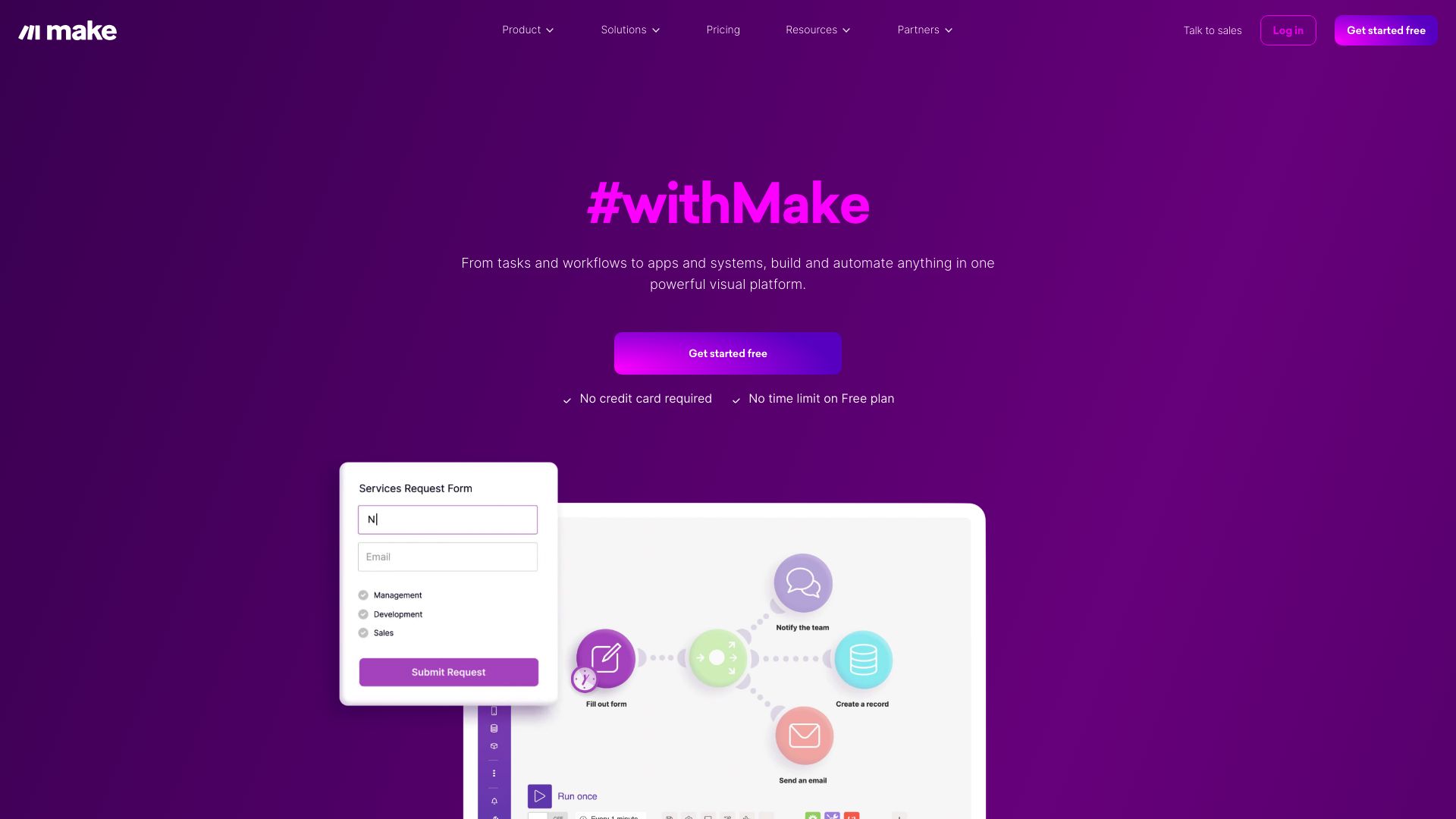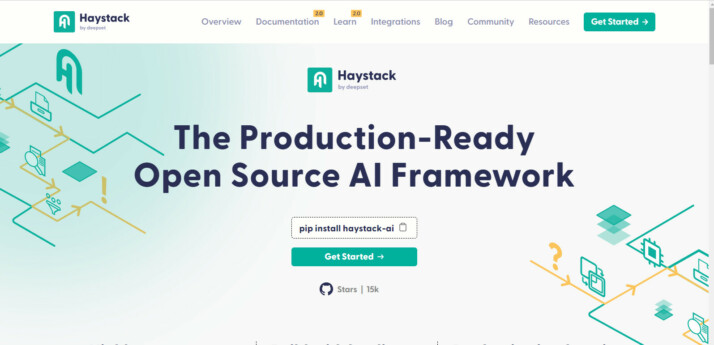Make.com vs. Haystack: Comparing AI Workflow Solutions
The AI landscape teems with solutions promising to revolutionize workflows and unlock new capabilities. This review dives deep into three key players: Make.com vs. Haystack, and SmythOS. Make.com offers a visual no-code platform for automating workflows across apps, while Haystack provides an open-source framework for building AI-driven applications. SmythOS emerges as a comprehensive solution, combining visual development with advanced AI agent capabilities. We’ll explore how each platform tackles automation, AI integration, and scalability, helping you navigate the choices for your next project. Whether you’re a developer seeking powerful AI tools, a business leader looking for enterprise-grade solutions, or a non-technical user aiming to harness AI’s potential, this comparison will equip you with the insights to make an informed decision.
Make.com Overview
Make.com provides a powerful visual automation platform for connecting apps and streamlining workflows without coding. The intuitive drag-and-drop interface allows users to build complex integrations called ’scenarios’ that link over 1000 popular apps and services.
Make.com provides a powerful visual automation platform for connecting apps and streamlining workflows without coding.


Make.com excels at automating repetitive tasks and data flows between applications. Users can schedule scenarios to run automatically, manipulate data with built-in tools, and monitor executions through detailed logs. The platform scales from simple personal automations to complex enterprise workflows.
While Make.com lacks AI agent capabilities, it compensates with robust integration options. The visual builder and no-code approach make it accessible for non-technical users to create sophisticated automations. Make.com also offers team collaboration features and handles bulk data processing efficiently.
Make.com positions itself as a versatile automation solution for businesses of all sizes. Its strengths lie in its extensive app integrations, visual workflow design, and scalability.
Make.com positions itself as a versatile automation solution for businesses of all sizes. Its strengths lie in its extensive app integrations, visual workflow design, and scalability. However, users seeking advanced AI functionalities or autonomous agents may find Make.com’s offerings limited compared to dedicated AI platforms.
Haystack Overview
Haystack stands out as an open-source framework for building production-ready applications using Large Language Models (LLMs), Transformer models, and vector search. Developed by deepset GmbH, Haystack excels in tasks like retrieval-augmented generation, document search, and question answering.
Haystack’s modular architecture allows developers to create custom search experiences and conversational chatbots by integrating tools such as Hugging Face Transformers, Elasticsearch, and OpenAI into flexible pipelines. This versatility makes it an attractive option for teams looking to leverage AI in various applications without being locked into a single vendor’s ecosystem.
Haystack’s modular architecture allows developers to create custom search experiences and conversational chatbots by integrating tools… into flexible pipelines.
One of Haystack’s key strengths lies in its ability to handle complex Natural Language Processing (NLP) tasks. The framework supports the entire lifecycle of NLP application development, from prototyping and experimentation to deployment and monitoring. This comprehensive approach enables developers to focus on building and improving their applications while the platform manages the intricacies of AI deployment and operations.
However, Haystack’s open-source nature means that users must handle their own hosting and infrastructure, which can be challenging for teams without extensive technical resources. Additionally, while the framework offers significant flexibility, it may require more setup and configuration compared to some fully-managed solutions.
Haystack’s impact on the NLP community is evident through its contributions, including specialized language models and datasets. The framework’s widespread adoption, with over 52 million downloads of their models as of August 2023, demonstrates its reliability and effectiveness in real-world applications.


Feature Comparison
Make.com and Haystack offer distinct approaches to workflow automation and AI development, with notable feature gaps between them. Make.com excels in visual workflow building and app integrations, while Haystack focuses on natural language processing and AI model deployment.
Make.com provides a robust visual builder and no-code options, enabling users to create complex workflows without coding. Its strength lies in connecting over 1000 apps through pre-built integrations. However, Make.com lacks AI agent capabilities, autonomous operations, and advanced NLP features. It doesn’t offer hosted AI models or vector databases, limiting its use for sophisticated AI applications.
Haystack, as an open-source framework, offers powerful tools for building AI-driven applications using large language models and vector search. It supports complex NLP tasks like retrieval-augmented generation and question answering. Unlike Make.com, Haystack integrates seamlessly with Hugging Face Transformers and popular AI models. However, Haystack requires more technical expertise and doesn’t provide a visual builder or no-code options, making it less accessible to non-technical users.
In terms of security, Make.com ensures data encryption and OAuth support, while Haystack’s open-source nature allows for customizable security implementations. Make.com offers built-in scheduling and monitoring features, whereas Haystack relies on external tools for these functionalities. Neither platform provides comprehensive multimodal capabilities or advanced features like constrained AI alignment.
SmythOS bridges many of these gaps, offering a visual builder, no-code options, and AI agent capabilities. It supports multimodal interactions, provides hosted solutions, and includes advanced features like constrained alignment and scalable vector databases. SmythOS combines the ease of use found in Make.com with the AI sophistication of Haystack, while adding unique capabilities that neither competitor fully addresses.
Feature Comparison Table
| Make.com | Haystack | SmythOS | |
|---|---|---|---|
| CORE FEATURES | |||
| AI Agents | ❌ | ✅ | ✅ |
| Hosted Agents (Dev, Production) | ❌ | ✅ | ✅ |
| Environments (Dev, Production) | ❌ | ✅ | ✅ |
| Visual Builder | ✅ | ❌ | ✅ |
| No-Code Options | ✅ | ❌ | ✅ |
| Memory & Context | ❌ | ✅ | ✅ |
| Autonomous Agents | ❌ | ✅ | ✅ |
| Explainability & Transparency | ❌ | ✅ | ✅ |
| Multimodal | ❌ | ✅ | ✅ |
| Problem-Solving Capabilities | ❌ | ✅ | ✅ |
| Multi-Agent Collaboration | ❌ | ✅ | ✅ |
| Human-AI Interaction | ❌ | ✅ | ✅ |
| Agent Work Scheduler | ✅ | ❌ | ✅ |
| SECURITY | |||
| Constrained Alignment | ❌ | ❌ | ✅ |
| Data Encryption | ❌ | ✅ | ✅ |
| IP Control | ❌ | ❌ | ✅ |
| COMPONENTS | |||
| Foundation AIs | ❌ | ✅ | ✅ |
| Huggingface AIs | ❌ | ✅ | ✅ |
| Zapier APIs | ❌ | ❌ | ✅ |
| Classifiers | ❌ | ✅ | ✅ |
| Data Lakes | ❌ | ❌ | ✅ |
| DEPLOYMENT OPTIONS (EMBODIMENTS) | |||
| Deploy as API | ❌ | ✅ | ✅ |
| Staging Domains | ❌ | ❌ | ✅ |
| Production Domains | ❌ | ❌ | ✅ |
| Deploy as Site Chat | ❌ | ✅ | ✅ |
| Deploy as Scheduled Agent | ✅ | ❌ | ✅ |
| DATA LAKE SUPPORT | |||
| Hosted Vector Database | ❌ | ✅ | ✅ |
| Sitemap Crawler | ❌ | ❌ | ✅ |
| YouTube Transcript Crawler | ❌ | ❌ | ✅ |
| URL Crawler | ❌ | ✅ | ✅ |
| PDF Support | ❌ | ✅ | ✅ |
| Word File Support | ❌ | ✅ | ✅ |
| TXT File Support | ❌ | ✅ | ✅ |
Best Alternative to Make.com and Haystack
SmythOS stands out as the superior alternative to Make.com and Haystack, offering a comprehensive platform for AI agent development and deployment. We combine the best of both worlds: the intuitive visual building capabilities of Make.com and the advanced AI features of Haystack, while adding unique functionalities that set us apart.
Our drag-and-drop interface empowers users to create sophisticated AI workflows without extensive coding knowledge. Unlike Make.com, which lacks AI agent capabilities, SmythOS enables the development of autonomous, intelligent agents that can handle complex tasks across various domains. We support integration with leading AI models from providers like OpenAI, Anthropic, and Hugging Face, giving users access to cutting-edge AI technologies.
SmythOS enables the development of autonomous, intelligent agents that can handle complex tasks across various domains.
While Haystack excels in natural language processing tasks, it requires significant technical expertise. SmythOS bridges this gap by offering advanced NLP capabilities within a user-friendly environment. Our platform supports multimodal interactions, allowing AI agents to process and respond to text, voice, and visual inputs seamlessly.
Unlike Make.com and Haystack, SmythOS provides a complete ecosystem for AI agent development, deployment, and management. We offer hosted solutions for both development and production environments, ensuring scalability and reliability. Our platform includes features like constrained alignment, ensuring AI agents operate within defined ethical and operational boundaries—a critical aspect often overlooked by other platforms.
SmythOS goes beyond basic automation, enabling the creation of truly intelligent systems that can learn, adapt, and collaborate. With our platform, users can deploy AI agents as APIs, chatbots, scheduled tasks, or even integrate them into existing applications. This versatility, combined with our robust security features and extensive integration options, makes SmythOS the ideal choice for businesses and developers looking to harness the full potential of AI technology.
Conclusion
Make.com, Haystack, and SmythOS each offer unique approaches to workflow automation and AI development, catering to different user needs and technical expertise levels. Make.com excels in visual workflow building and app integrations, making it accessible for non-technical users. Haystack provides powerful tools for AI-driven applications, particularly in NLP tasks, but requires more technical knowledge. SmythOS emerges as a comprehensive solution, combining the strengths of both while addressing their limitations.
SmythOS stands out with its intuitive drag-and-drop interface, extensive AI capabilities, and versatile deployment options. Unlike Make.com, it offers advanced AI agent functionalities and supports complex NLP tasks. In contrast to Haystack, SmythOS provides a user-friendly visual builder and no-code options, making AI development accessible to a broader audience. The platform’s support for multimodal interactions, hosted solutions, and features like constrained AI alignment set it apart in the field.
For businesses and developers seeking a balanced solution that combines ease of use with advanced AI capabilities, SmythOS offers compelling advantages. Its ability to create and deploy AI agents across various platforms, coupled with extensive integration options and scalable infrastructure, positions it as a versatile tool for modern AI-driven workflows.
To explore how SmythOS can transform your AI development and automation processes, create a free SmythOS account today. Experience the power of AI agent creation with our risk-free trial, offering unlimited agents and a 30-day money-back guarantee. Discover our diverse range of AI-powered agent templates to jumpstart your projects and unleash the potential of 300,000+ seamless integrations for your AI workflow. Start building the future of your business with SmythOS – where innovation meets simplicity.
Last updated:
Disclaimer: The information presented in this article is for general informational purposes only and is provided as is. While we strive to keep the content up-to-date and accurate, we make no representations or warranties of any kind, express or implied, about the completeness, accuracy, reliability, suitability, or availability of the information contained in this article.
Any reliance you place on such information is strictly at your own risk. We reserve the right to make additions, deletions, or modifications to the contents of this article at any time without prior notice.
In no event will we be liable for any loss or damage including without limitation, indirect or consequential loss or damage, or any loss or damage whatsoever arising from loss of data, profits, or any other loss not specified herein arising out of, or in connection with, the use of this article.
Despite our best efforts, this article may contain oversights, errors, or omissions. If you notice any inaccuracies or have concerns about the content, please report them through our content feedback form. Your input helps us maintain the quality and reliability of our information.
